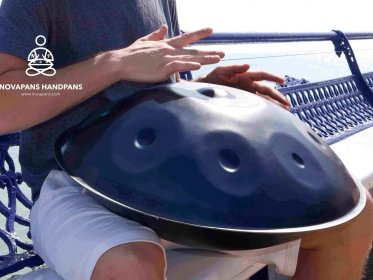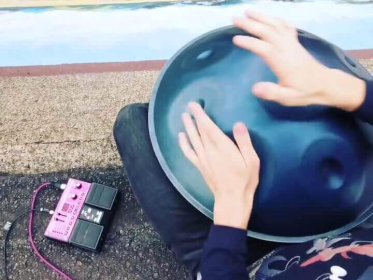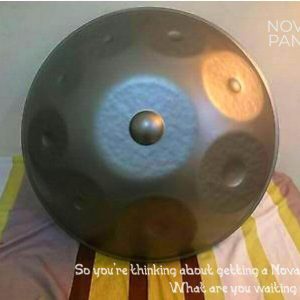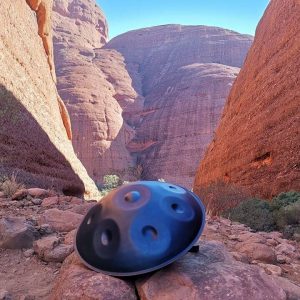The History of HandPans: Part 1

The History of Hand Pans: Part One
How the Steel Pan Came to Be: A Story of Oppression and Rebellion
Its widely acknowledged that the history of the hand pan is rooted in the steel pan of Trinidad and Tobago, and that the steel pan influenced the makers of the first ‘Hang' in Switzerland (but that's a story for another time…well, post). But what you might be interested to know is how the steelpan (the ‘father’ of the hand pan, if you will!) came to be; just how much struggle, and how much change at a socio-economic level, is in the history of the elegant instrument that might sit somewhere near you at this very moment (or that you may be considering purchasing).
In its most expressive and powerful manifestations, music is about sharing a sense of celebration; the steel pan was born to meet that need in the face of (often violent) suppression by the authorities. Although the steel pan came to be accepted by their British oppressors, its precursors (the ‘grandparents’ of the hand pan, if you will!) were used to stick it to the man in the context of colonial Trinidad & Tobago, and the British were much less receptive to them than they are today.
The Caribbean islands were hotly contested by the colonial forces of Spain, France and Britain, with the population growing from 1,400 to over 15,000 as settlers of each country transported West Africans there as slaves. These slaves were forced to harvest sugar cane, a process so labour-intensive that slaves from neighbouring farms were forced to march to each farm to help, because the sugar cane had been burned, and so it had to be gathered extremely quickly before it spoiled.
(If this all sounds a bit academic, don’t worry - we'll get to music soon enough!)
The influence of the French resulted in the celebration of Carnival in Trinidad & Tobago, but the slaves and servants, and later their freed descendants, were banned from participating (sadly, I’m sure I don’t have to tell you why).
So they set up their own carnival called Canboulay, which is a direct precursor of today's Trinidad & Tobago Carnival (and so London's Notting Hill Carnival, Toronto's Caribana, and numerous others). The Canboulay processions were hugely popular, and involved displays of Kalenda, a West-African mixture of martial art, war dance and folk music in which the participants used sticks.
This worried the wealthy European settlers (because, of course it did!), and so the British police did everything they could to suppress Canboulay, including banning traditional African percussion instruments on the islands.
Understandably, there were deep tensions between the black and white populations of Trinidad & Tobago.
With the police looming over the processions, looking for any excuse to shut down the festivities, the Canboulay Riots erupted in 1881. The authorities cracked down hard, first banning the use of African instruments, and then banning drumming altogether in 1883. Even stick-fighting was banned in 1884.
But the musicians did not lie down quietly and accept the suppression of their culture; instead they pursued other ways of making music, with whatever tools they could find. Obviously, no matter how hard the British might have tried, they couldn't stop people from getting their hands on the bamboo that grew naturally on the islands!
At the turn of the 20th Century, the dominant form of Canboulay music was Tamboo Bamboo (literally French for drum of bamboo). This involved three instruments, each cut from bamboo; the boom (a bass instrument), the foulé (higher-pitched), and the cutter (the highest-pitched). These three types of instruments combined to beat out different rhythms, and were hugely popular, until the arrival of the steel pan…
Among the many repurposed objects that found their way into the hands of musicians were bottles and spoons, kettle drums and repurposed oil drums - these oil drums were, of course, being used by the British colonialists to steal Trinidad & Tobago’s natural oil reserves. The striking of automobile brake hub iron came to replace the high-pitched percussion of spoons on bottles. The booms of biscuit-drums on the ground eclipsed the "bass" of "booms" created by 5-foot long bamboo sticks. However, for a long time the emphasis was on the rhythm of the instruments rather than the melody. That was until...
Ellie Mannette
Ellie Manette is considered by most to be the "father of the modern steel pan" and so we could almost call him the grandfather of the handpan! He recalls that, one day after school, he started beating on a trash can, and could make the same kind of rhythm as the tamboo bamboo bands he could hear nearby as more and more bands took to trash cans. He also acknowledges, though he never met the man, that Winston "Spree" Simon was the first man to play a distinct melody on a trash can.
Whereas the steel pan is a concave basin (i.e. it slopes downward), the trash cans that Winston was playing were convex (because he was beating sticks on trash cans with the lids on). As more and more musicians begin playing, and experimenting, with trash cans and oil drums, they would take broom handles and dent the curves in various places. When these new pans were played, whether with a stick or by hand, each dent played a different note! By 1940, many underprivileged young men were playing these instruments in Carnival, and people were noticing...
Ellie Mannette began experimenting with different ways of denting the metal to emulate the melodies he was hearing;
"It was driving me crazy because [other players] were getting the melody and I couldn't get it...So I say "How come they could get a melody on those convex and I can't do it? I dent it in all kinds of crazy ways. So I decided, y'know what? I'm going to sink the drum...And instead of putting a convex, with a little dimple, I put a concave with a hump.
So the concave, when I push the hump up, you can hit on the hump and control it"
That was in 1941. As the steel drum grew in popularity amongst the people of Trinidad & Tobago, it also became popular with American soldiers stationed there throughout WWII. Even the British government caught on, and in 1951 Mannette and his band were tutored by an English professor of music, eventually playing in the 1951 Festival of Britain.
Ellie returned to Trinidad & Tobago in 1952 with an in-depth knowledge of music terminology and an appreciation for how to achieve the depth and range he knew the steel pan was capable of: "I went like wildfire."
From 1952 until his death in 2018, Ellie Mannette met with musicologists, metallurgists, and all kinds of experts to keep refining the process of building steel pans, and has even held and played what we would consider a modern-day hand pan;
"I wrote a song of my life and I said;
I always knew in my heart one day
That my work would find its way
I could not tell you how
There was no-one there for me to show the way
But I figured it out.
I figured it all through for you to see today"
If you’re interested in how the steel pan came to Switzerland, and eventually led to the creation of the hand pan, you can read the next part of the History of Handpans: From Ellie Manette to Felix Rohner (the inventor of the first ‘Hang’).
And, of course, if you’re interested in purchasing a hand pan, we welcome you to check out our selection!
Discover our handpans
-
9 Note Handpan in D Pentatonic Minor | Generation 1
$1,299.00 Select options This product has multiple variants. The options may be chosen on the product page -
9 Note Handpans in Multiple Keys (Kurd / Hijaz / Amara / Pygmy / Major / Sabye) in 440hz or 432hz | Generation 3
Original price was: $1,599.00.$1,399.00Current price is: $1,399.00. Select options This product has multiple variants. The options may be chosen on the product page -
Handpan Raffle
$5.00 Select options This product has multiple variants. The options may be chosen on the product page
More post about handpans

brizy_dc_post_title
However, there are some basic entry-level techniques which can really help accelerate the learning curve for development.

brizy_dc_post_title
By using the following few steps, you should be well on your way to picking a handpan which suits your needs to best of your situation



